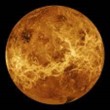by Patricia Jeffery © 2024 of the Calgary Centre of the Royal Astronomical Society of Canada
Mercury

- Closest planet to the Sun.
- If our Sun is the goal post of a CFL football field, Earth would be at the two-yard line; Mercury on the 0.8-yard line.
- Smallest planet, only slightly larger than Earth’s Moon.
- Very faint; visible only after sunset or before sunrise.
- Rotates on its axis in 59 days. It takes 88 days to orbit the Sun.
- Sunlight takes three minutes to get there.
- No moons or rings.
- Rocky, heavily cratered surface.
- Only two probes have ever been sent there; neither landed.
- A blistering 430-degree Celsius during the day. A bone chilling -170-degree Celsius at night.
- Any water or atmosphere it once possessed has long since boiled away.
Venus

- Second planet from the Sun.
- Using the above CFL field comparison, Venus is on the 1.4-yard line.
- Slightly smaller than Earth.
- Second only to our Moon in brightness.
- Rotates on its axis in 243 days. It takes 225 days to orbit the Sun, making its year shorter than its day.
- Takes sunlight six minutes to get there.
- No moons or rings.
- Unlike every other planet, Venus spins clockwise. Scientists believe this is because Venus is actually upside down; meaning the Sun rises in the west and sets in the east.
- While it has an atmosphere, it is a poisonous concoction of carbon dioxide and sulphuric acid which has produced a runaway greenhouse effect. With an average temperature of 460-degree Celsius, Venus is hotter than Mercury, despite being further from the Sun.
- Russia has landed several probes on the surface, but none survived more than two hours; having been crushed flat by an atmospheric pressure of 1,350 pounds per square inch, then melted by the scorching temperatures.










